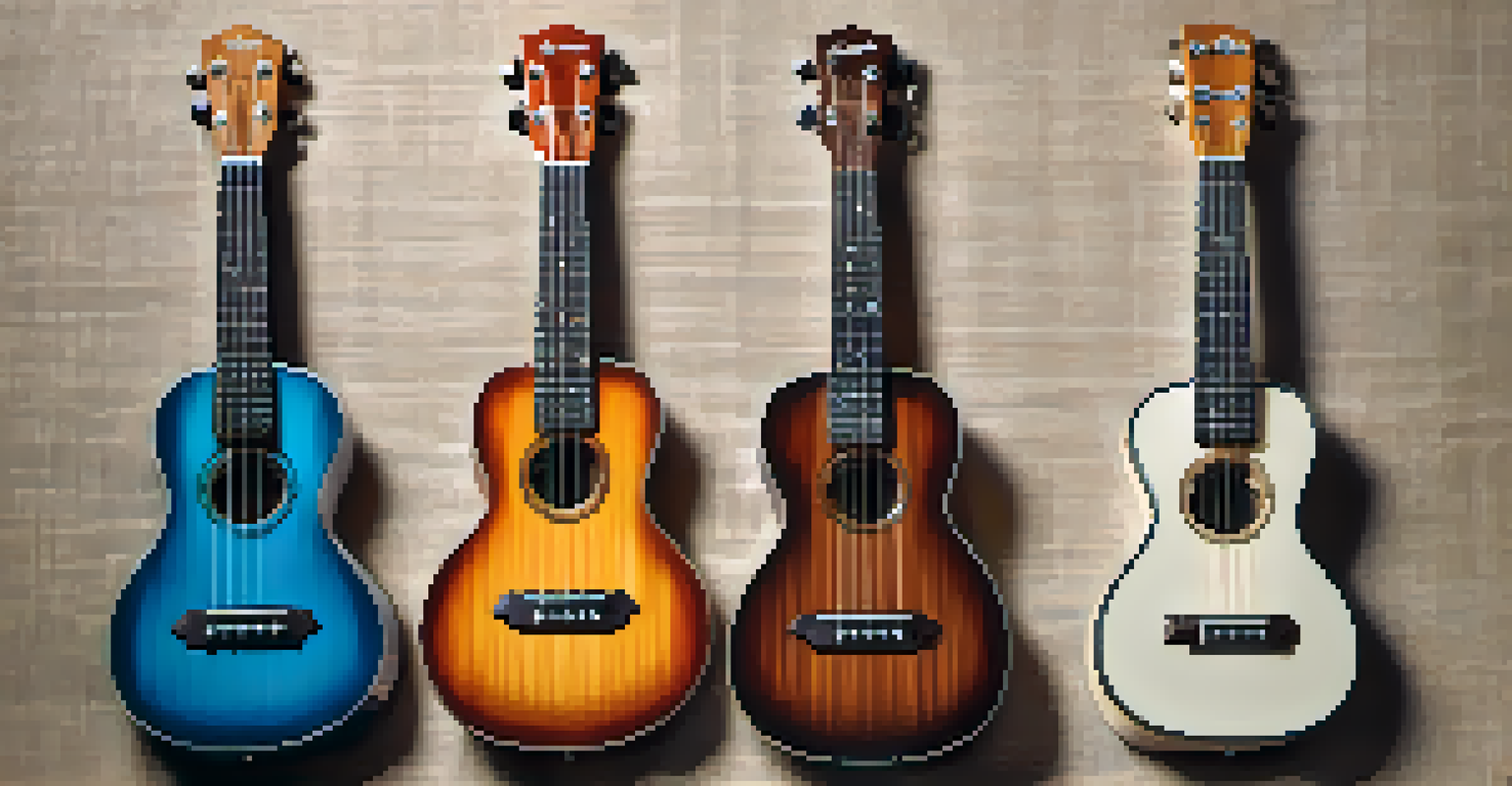The Rise of the Electric Ukulele: A Design Revolution

Introduction to the Electric Ukulele Phenomenon
The electric ukulele has surged in popularity, captivating musicians and enthusiasts alike. With its unique blend of traditional charm and modern technology, this instrument is making waves in the music world. Many are drawn to the electric ukulele for its versatility, allowing players to explore various genres beyond just Hawaiian music.
Music is the shorthand of emotion.
This shift towards electrification represents a broader trend in the music industry, where innovation meets tradition. As musicians seek new ways to express themselves, the electric ukulele offers an exciting alternative. It’s not just a tool for performance; it's a canvas for creativity, inviting players to experiment with sound.
In this article, we'll dive into the design revolution of the electric ukulele, exploring its history, evolution, and the impact it has on musicians today. From its humble beginnings to its current status as a staple in modern music, the electric ukulele is here to stay.
The History of the Ukulele: A Brief Overview
The ukulele originated in the 19th century, brought to Hawaii by Portuguese immigrants. Initially crafted from wood, it quickly gained popularity for its cheerful sound and portability. The traditional ukulele has long been associated with Hawaiian culture, but its appeal has transcended borders.

As the music landscape evolved, so did the ukulele. The introduction of electric components began reshaping its identity in the mid-20th century, allowing musicians to amplify their sound. This transformation opened the door for new styles and genres, captivating a broader audience.
Electric Ukulele's Unique Versatility
The electric ukulele combines traditional charm with modern technology, enabling musicians to explore a wide range of musical genres.
Understanding the ukulele's history provides context for the electric version's rise. It highlights how an instrument can adapt and thrive amidst changing musical trends, proving that innovation is just as important as tradition.
The Design Evolution: From Acoustic to Electric
The transition from acoustic to electric ukuleles reflects significant advancements in instrument design. Electric ukuleles often feature solid bodies, pickups, and built-in effects, enhancing their sound and playability. These design changes not only modernize the instrument but also expand its capabilities.
The beautiful thing about learning is that no one can take it away from you.
Manufacturers have embraced various materials and technologies to create unique electric ukuleles. For instance, the use of lightweight woods and composite materials offers durability without sacrificing sound quality. This evolution allows musicians to choose instruments that suit their personal style and performance needs.
Ultimately, the design evolution of the electric ukulele signifies a commitment to innovation in music. It demonstrates how thoughtful engineering can enhance an instrument's appeal while honoring its rich heritage.
Impact on Music Genres: Broadening Horizons
The electric ukulele has made significant strides across diverse music genres, from pop to rock and beyond. Artists are increasingly incorporating it into their compositions, showcasing its versatility and unique sound. This has led to a fusion of styles, enriching the musical landscape.
For example, bands like Twenty One Pilots and Vance Joy have integrated the electric ukulele into their hits, giving the instrument a modern twist. Listeners are treated to a refreshing blend of familiar melodies with new, electrifying elements. This cross-genre appeal is helping to redefine the ukulele's role in contemporary music.
A Thriving Community Emerges
As the electric ukulele gains popularity, a vibrant community of enthusiasts fosters connections and encourages collaboration among players.
As musicians continue to experiment with the electric ukulele, we can expect to see even more genre-blurring collaborations. This evolution not only broadens the instrument's horizons but also encourages a new generation of players to explore its potential.
The Electric Ukulele: A Tool for Creativity
One of the most compelling features of the electric ukulele is its capacity for creativity. With built-in effects like reverb and distortion, players can easily manipulate their sound, making it a versatile instrument for songwriting. This capability allows musicians to break free from traditional boundaries and explore new sonic territories.
For many, the electric ukulele serves as an entry point into music production. Its lightweight design and user-friendly nature make it accessible for beginners, while still offering depth for seasoned players. This accessibility encourages collaboration and experimentation, fostering a vibrant community of musicians.
Ultimately, the electric ukulele empowers artists to express their individuality. It’s not just about playing notes; it's about creating a unique sound that reflects personal style and artistic vision.
The Community of Electric Ukulele Enthusiasts
As the electric ukulele gains momentum, a vibrant community of enthusiasts is emerging. Online forums, social media groups, and local meetups are fostering connections among players. This sense of community encourages sharing tips, resources, and inspiration, making the journey of learning more enjoyable.
Events like ukulele festivals and workshops are also on the rise, allowing players to showcase their skills and discover new techniques. These gatherings promote a sense of belonging, as musicians bond over their shared passion for the instrument. The electric ukulele community is inclusive and welcoming, inviting players of all skill levels to join in.
Future Innovation in Design
Ongoing advancements in technology and materials promise to enhance the electric ukulele's sound quality and playability, ensuring its relevance in modern music.
This community aspect enhances the overall experience of playing the electric ukulele. It's not just about mastering the instrument; it's about connecting with like-minded individuals who inspire and uplift each other.
Future Trends: What’s Next for Electric Ukuleles?
Looking ahead, the future of the electric ukulele appears bright, with ongoing advancements in technology and design. Manufacturers are likely to continue exploring innovative materials and features, further enhancing sound quality and playability. This commitment to progress will keep the electric ukulele relevant in the ever-changing music landscape.
Additionally, as music education evolves, we may see more emphasis on incorporating electric ukuleles into school curricula. This shift could introduce young musicians to the instrument early on, fostering a new generation of players who embrace its modern capabilities. Such initiatives will help sustain interest and growth in the electric ukulele community.

In summary, the electric ukulele is poised for an exciting future, driven by innovation and a passionate community. As it continues to evolve, we can expect it to inspire even more musicians to explore its potential and redefine their musical journeys.